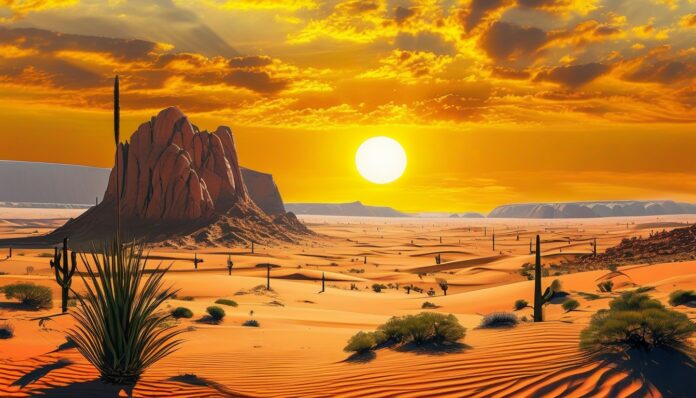Africa holds many amazing secrets, and one of them is the Sahara Desert. Though much has been learned about this vast expanse, there are still mysteries that remain unsolved.
Geographic and Geological Information
The Sahara Desert is mainly located in northern Africa, covering 10 African countries. It spans an area of over 9 million square kilometers, stretching 4,800 km from the Red Sea to the Atlantic Ocean, and 1,000 km from north to south. Scientists believe that once-fertile lands turned into desert around 3,000 years ago. Most of the desert is flat, but in some areas, there are highlands where snow occasionally falls in winter. To the south, there is a depression that holds remnants of an ancient ocean, including Lake Chad, the only freshwater source for nearby regions.
Interestingly, only 25% of the desert is covered by sand, with the rest consisting of rocky terrain, volcanic soil, and gravel. Rarely, oases can be found—small fertile areas with lakes fed by underground water.
Climate Conditions
The Sahara is the hottest and driest desert on the planet. Summer temperatures can reach 60°C (140°F), with the sand heating up to 80°C (176°F). In winter, temperatures in the mountains can drop to -18°C (0°F), and snow falls almost yearly in areas like the Ahaggar and Tibesti plateaus. Rainfall is scarce, around 80 mm per year, mostly occurring in autumn and spring. Sometimes, brief but severe floods and thunderstorms can happen.
In the southern parts closer to the tropics, the climate is milder with fewer extreme temperature shifts and more frequent rainfall. In the west, near the Atlantic Ocean, fog is common. Strong winds frequently blow in the northern parts, often causing sandstorms with winds reaching speeds of 50 m/s, carrying sand and small stones, which can be dangerous for travelers.
Flora and Fauna
Despite the harsh climate, the Sahara is home to some incredible plants and animals. The flora mainly consists of xerophytes, plants adapted to survive with minimal water. In highlands and oases, date palms, olives, cypresses, and citrus trees can grow, with some plants being important exports for African countries. Seeds of some plants can survive in a state of dormancy in the soil for several years, waiting for rain.
The fauna is richer, especially in terms of invertebrates. Among mammals, there are unique grazing species like antelopes and gazelles, predators like jackals, hyenas, and cheetahs. Desert crows are common, and there are many species of lizards. Crocodiles can be found in the waters of certain oases. Particularly dangerous are the Saharan horned viper, an endangered species, and other venomous creatures such as the yellow scorpion and gray monitor lizard. The African ostrich is also well adapted to life in the desert.
Mysteries of the Desert
- Mirages: The Sahara is known for its mirages, optical illusions caused by hot air that reflects distant objects. Combined with stone and sand pillars formed by wind, the human mind may create detailed illusions. Some mirages, such as the “Fata Morgana,” are so complex that they can appear as entire cities in the sky. Experienced travelers even have maps indicating where mirages are most frequent. There have been cases where entire caravans perished after being misled by these illusions.
- The Lost Army of Cambyses II: About 2,500 years ago, a 50,000-strong Persian army led by King Cambyses II mysteriously disappeared in the Sahara sands. Recently, Italian archaeologists discovered a large number of bones, bronze weapons, and jewelry near the location where the army vanished. It is believed they were caught in a massive sandstorm, leading to their demise.
- The Eye of the Sahara: This striking formation of stone rings, up to 50 km in diameter, can be seen from space without magnification. Known as the Richat Structure, scientists are still puzzled by its origin. Theories suggest it may be the result of a meteorite impact, volcanic activity, or a unique form of erosion.
- The Great Martian God: Archaeologists once discovered mysterious ancient rock carvings in Algeria, depicting human figures, with one large-headed figure resembling an astronaut’s helmet. These drawings, about 6,000 years old, remain a mystery, intriguing both scientists and UFO enthusiasts worldwide.
